
Surveys
DJC.COM
December 9, 2004
Seattle's waterfront can be an amenity for the region
Allied Arts
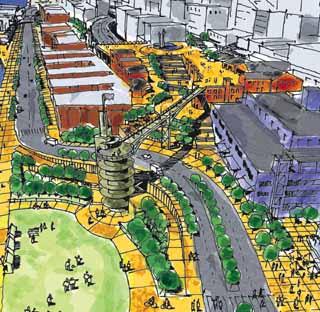
Image by Matt Roewe
One vision for Seattle's viaduct-less waterfront includes a grand walkway from Steinbrueck Park to the aquarium.
|
With all the debate about how we'll pay to replace the Alaskan Way Viaduct and whether we should rebuild it, tunnel it or just tear it down, we sometimes lose sight of why most people want the viaduct gone.
It's hard to imagine a fate worse for a neighborhood than running a highway through it — especially the double-decked and elevated variety. Not only do highways destroy the desirability of the area for at least a block in each direction, they work like concrete walls, discouraging people from crossing them.
Once we replace the viaduct with a waterfront tunnel, we'll have the opportunity to make a great civic space that connects adjacent neighborhoods to the sea and becomes a destination for people all around Puget Sound.
So let's imagine what a tunnel can do for the waterfront, the neighbors and even people miles away.
Though it's tempting to think of the Seattle waterfront as a long, narrow district, really it's the beginning (or end) of several nearby neighborhoods. At one time Pioneer Square was connected to the water's edge and grew because of its proximity to the sea. But since the viaduct was built, buildings on the west edge of Pioneer Square have turned their faces away from the highway as well as the bay.
Once the viaduct is gone, the charm of First Avenue in Pioneer Square could bring the flavor of the oldest part of downtown right to the front door of the new ferry terminal, linking two historic yet estranged neighborhoods.
The cultural corridor
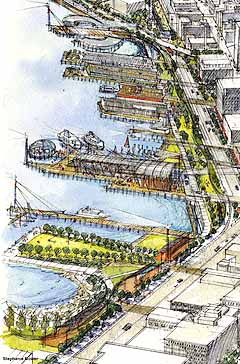
Image by Stephanie Bower
Much of the land where the viaduct stands could become a waterfront park system.
|
Connections to a viaduct-free waterfront will also enable other nearby neighborhoods to ripen. For example, University Street is becoming Seattle's cultural corridor.
With the symphony hall on Second, the Art Museum on First and Harbor Steps leading down to the waterfront, it's only natural for the parking lot on University between Western Avenue and Alaskan Way to become a "Plaza of the Arts," a piazza with galleries, lunchtime concerts, street musicians, jugglers and puppeteers.
Imagine the Seafair parade on Alaskan Way, instead of land-locked Fourth Avenue.
The market connection
Pike Place Market is Washington's top tourist destination. It's authentic to the Northwest and locals use it as much if not more than visitors. A unique opportunity exists to intermingle the character of the market with the waterfront by creating a grand descent from Steinbrueck Park to the aquarium, over the footprint of the viaduct.
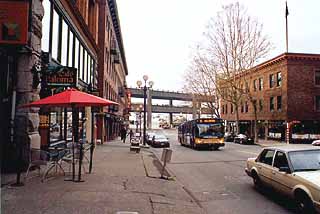
The viaduct walls off Yesler Way from the waterfront.
|
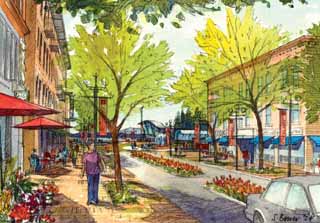
Images by Stephanie Bower
Without the viaduct, Yesler Way could be a pedestrian-friendly link to Elliott Bay.
|
This grand "Market to Waterfront Walkway" would give everyone — not just drivers — a panoramic view of Elliott Bay.
When our ancestors built the viaduct, they did us a favor. Without the viaduct, all the land under the highway would have been developed, probably with view-blocking skyscrapers from the 1970s and 1980s. But since land under the viaduct is owned by the city, we have an opportunity to create the great downtown park that Seattle so dearly needs.
Specifically, a great urban park is exactly what places like SoDo, the International District and the Pike/Pine Corridor need. Access to a major park could help SoDo become like Portland's Pearl District, where light industry, housing, restaurants and retail live together within blocks of McCall Waterfront Park on the Willamette River.
A regional amenity
Some say the farther people live from the waterfront the less they care about the neighborhood and the more they care about the highway running through it. But people in neighborhoods all around Puget Sound as well as east of the Cascades will benefit from the new waterfront — even more than they will the tunnel.
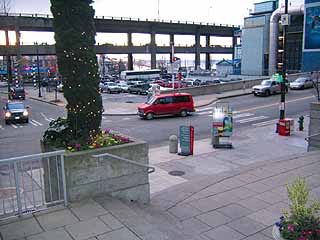
Photo by David Yeaworth
Today's parking lot at University and Alaskan Way...
|
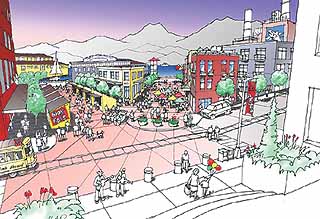
Image by Matt Roewe
...could become an arts plaza.
|
Big cities provide regional amenities such as major league sports teams, historic landmarks and high-quality arts. Seattle's waterfront will become an amenity for the region like Mount Rainier, Seattle Center or the Mariners, a place in which we all take pride and show to visitors.
The new waterfront will give suburban, rural and urban families another great reason to get out of the house and create the kind of memories that come from living in a place blessed with the rich quality of life that we savor in Washington.
Leadership needed
A great, civic-oriented waterfront won't come to fruition just because we tear down the viaduct. The good news is that most of the key players are poised to do the right thing. The one missing element is leaders who can work with all of the landowners, stakeholders and developers to create a vision and implement it.
Civic momentum is coming together and growing. With an ounce of luck and a ton of leadership, the Seattle waterfront will become our region's next great treasure.
David Yeaworth is president of Allied Arts.
Other Stories:
- CBA's Insights program turns eight years old
- Real estate's important role in mass transit
- Sleepy Spokane awakes to a real estate renaissance
- Let's go downtown — Bellevue, that is
- Seattle's goal: create community, not crowds
- How mixed-use can save commercial districts
- Low-income housing goes green
- Seattle's land code needs a diet
- Does your landlord have too much control?
- Alderwood gets urbanized and upscaled
- For Eastsiders, it's been the best recession ever
- Owners' reps keep a lid on project costs
- Downtown Seattle office market: Is less worth more?
- Eli Khouri
- Patrick Callahan
- Matthew J. Griffin
- Don Milliken
- Frank Stagen
- Soggy building? Better check your insurance
Copyright ©2009 Seattle Daily Journal and DJC.COM.
Comments? Questions? Contact us.